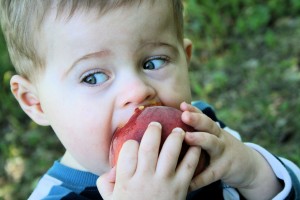 Have you ever worried as to whether your preschooler is eating enough vegetables? Or have you ever battled with your toddler to eat his dinner? If so, you are definitely not alone as worries about children’s eating habits are one of the most frequently reported problems in the early years. The good news is that though getting your children to eat well and healthily is a long term project there are a lot of simple habits that you can establish as a parent that can make a difference and take the stress out of mealtimes.
Have you ever worried as to whether your preschooler is eating enough vegetables? Or have you ever battled with your toddler to eat his dinner? If so, you are definitely not alone as worries about children’s eating habits are one of the most frequently reported problems in the early years. The good news is that though getting your children to eat well and healthily is a long term project there are a lot of simple habits that you can establish as a parent that can make a difference and take the stress out of mealtimes.
Adapt to your child’s eating style
Parents often have unrealistic expectations about their children’s eating, hoping that they will have three meals a day and enjoy adult dinners and/or the range of foods that grown ups like. However, developmentally, young children tend to eat a more limited range of food than adults, though this can still be a healthy mix and cover all of the major food groups.
Closely observe your child and they may be eating more healthily than you think. In addition, some children tend to adopt a ‘grazing’ style by eating ‘little and often’ rather than having three square meals a day. If this is the case, you are likely to be more successful in having smaller but more frequent meals and letting children choose from a range of healthy foods and snacks between meals.
Make mealtimes relaxed, enjoyable times
When children do eat, try and make mealtimes a relaxed, enjoyable experience and try to remove any pressure from mealtimes. Food is most enjoyed when it can be eaten slowly. Make sure you are not rushing but have time to sit with your child as they eat.
Research shows that children are more likely to settle at the table to eat when their parents are sitting with them eating at the same time (rather than rushing around to serve or standing up eating themselves). Aside from encouraging healthy eating, the routine of a relaxed family meal has many other benefits for children and parents, such as giving them time to chat and connect with one another.
Remember you are not responsible for your child eating!
Remember that as a parent you can’t make your child eat, but you can control what food they have access to and ensure that there are regular and relaxed mealtimes.
Nutritionist Ellyn Satter, put this very well suggesting that a successful mealtime requires a division of responsibility: ‘Parents are responsible for the what, when and where of feeding; Children are responsible for the how much and whether of eating.’
Frequently introduce your child to healthy food
Research shows that repeated exposure and experience of healthy food and vegetables is the best way to get children to eat them. Parents should remember that children may have to be exposed up to 20 times to a particular food before they might eat it. They might first smell it, take a small part in and out of their mouth before they even take a small bite. It is crucial to be patient and positive and praise little small steps – ‘good to see you tried a bit of the apple’ etc.
Start with very small portions of new foods, perhaps alongside familiar foods and only aim for her first to tolerate the food on her plate, before maybe taking a bite the next time.
Be creative about how you introduce vegetables and healthy food
The more creative and varied you can be in introducing new foods the better. For example, carrots can be eaten raw or cooked, served in a soup or added to a smoothie. They can also be ‘hidden’ in mashed potato or in a meatloaf. You could also make your child’s favourite dip (such as guacamole) and then cut the carrots into batons for them to eat with it.
Sometimes, simply presenting vegetables in a different container can make a difference – the carrots might appear more appealing in a favourite cup or beaker.
Take time to teach your children about healthy eating.
You can do this by:
• Involving children in the preparation of the food. Show them how to peel fruit and slice eggs or how to make a nutritious smoothie or how to cook a healthy stew
• Involving your child in shopping for food and in choosing which vegetables to have for dinner
• Reading books together on healthy eating and cooking.
• Growing some of your own food and getting your child to help with planting the seeds and harvesting the results
Model health eating
Finally, in the long term, children are most likely to learn from how you behave rather than what you tell them. The more you can be a role model to your children about eating healthy food, the better. If your children see you eating and enjoying healthy food, this will most likely influence them. If your children see you grabbing an apple rather than a cake as a snack (and once again enjoying it!) they will be more tempted to try one.
Dr. John Sharry, Irish Times Newspaper, Oct 2011. John writes in the Irish Times Newspaper every second Tuesday. Find out more about his talks and books for parents at: www.solutiontalk.ie
